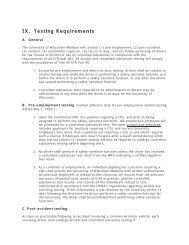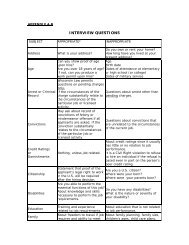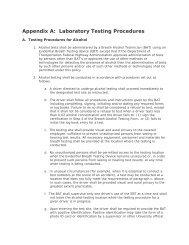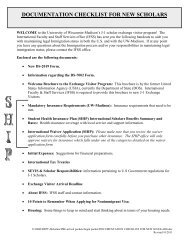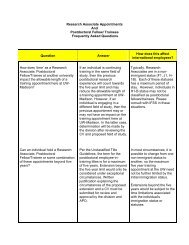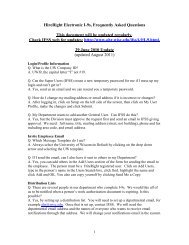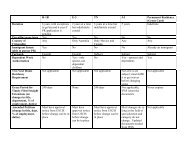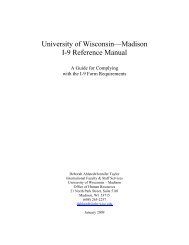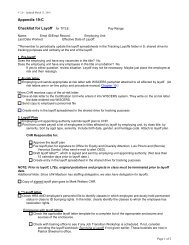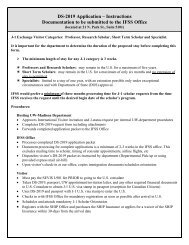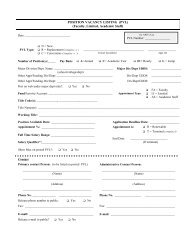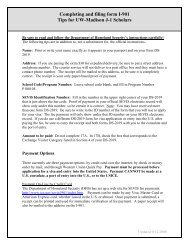FMLA Form-Employee - OHR - University of Wisconsin–Madison
FMLA Form-Employee - OHR - University of Wisconsin–Madison
FMLA Form-Employee - OHR - University of Wisconsin–Madison
Create successful ePaper yourself
Turn your PDF publications into a flip-book with our unique Google optimized e-Paper software.
UNIVERSITY OF WISCONSIN-MADISON<br />
CERTIFICATION OF FAMILY AND MEDICAL LEAVE<br />
FOR EMPLOYEE’S SERIOUS HEALTH CONDITION<br />
For Office Use Only<br />
Person ID: _________<br />
UDDS: ____________<br />
SECTION I: For Completion by the EMPLOYEE<br />
<strong>Employee</strong>’s Name:<br />
Department/Unit:<br />
Job Title:<br />
Name <strong>of</strong> Supervisor:<br />
INSTRUCTIONS to the EMPLOYEE: Please give this form to your medical provider for completion.<br />
The Family and Medical Leave Act (<strong>FMLA</strong>) permits an employer to require that you submit a timely,<br />
complete and sufficient medical certification to support a request for <strong>FMLA</strong> leave due to your own<br />
serious health condition. If requested by your employer, your response is required to obtain or retain the<br />
benefit <strong>of</strong> <strong>FMLA</strong> protections. Failure to provide a complete and sufficient medical certification may result<br />
in a denial <strong>of</strong> your <strong>FMLA</strong> request. Your employer must give you at least 15 calendar days to return this<br />
form.<br />
For more information on the <strong>FMLA</strong>, visit the Department <strong>of</strong> Labor’s website at<br />
http://www.dol.gov/compliance/laws/comp-fmla.htm<br />
For more information on the W<strong>FMLA</strong>, visit the Wisconsin Department <strong>of</strong> Workforce Development<br />
website at http://www.dwd.state.wi.us/er/family_and_medical_leave/default.htm<br />
______________________________________________________________________________<br />
SECTION II: For Completion by the HEALTH CARE PROVIDER<br />
INSTRUCTIONS to the TREATING SPECIALIST: Your patient has requested leave under the<br />
<strong>FMLA</strong>. Answer, fully and completely, all applicable parts, paying attention to the specific points listed<br />
here. Limit your responses to the condition for which the employee is seeking leave.<br />
*Please be sure to sign the last page.<br />
Your answer should be your best estimate based upon your medical knowledge, experience, and<br />
examination <strong>of</strong> the patient.<br />
Be as specific as you can; terms such as “lifetime,” “unknown,” or “indeterminate” may not be<br />
sufficient to determine <strong>FMLA</strong> coverage. You may be requested to clarify your answer if these<br />
terms are used.<br />
Treating Specialist’s name: ___________________________________________________ (please print)<br />
Treating Specialist’s business address: ____________________________________________________<br />
___________________________________________________<br />
Type <strong>of</strong> practice/ Medical specialty: _______________________________________________________<br />
Telephone (_______)_________________________ Fax: (_______)_____________________________<br />
Based on U.S, DOL form WH-380-E November 2008<br />
<strong>University</strong> <strong>of</strong> Wisconsin Madison-Revised April 30, 2010<br />
1
Name <strong>of</strong> <strong>Employee</strong>: ___________________________________<br />
PART A: MEDICAL FACTS<br />
1. I certify that _______________________________________________________________________<br />
Does have a serious health condition (described on page 4)* and qualifies under the category<br />
checked below:<br />
1)_____ 2)_____ 3)_____ 4)_____ 5)_____ 6)_____<br />
Does not have a serious health condition (described on page 4).* Provide signature and return<br />
form to address listed.<br />
*Page 4 describes what is meant by a “serious health condition" under the Family and Medical Leave Act.<br />
2. Approximate date condition commenced: ________________________________________________<br />
Date(s) you treated the patient for this condition: _________________________________________<br />
Probable duration <strong>of</strong> condition*: _______________________________________________________<br />
* Be as specific as you can; terms such as “lifetime,” “unknown,” or “indeterminate” may not be sufficient to<br />
determine <strong>FMLA</strong> coverage. You may be requested to clarify your answer if these terms are used.<br />
If for pregnancy, indicate expected delivery date: ______________________________________<br />
3. Describe the medical facts regarding the serious health condition that impede the employee’s ability to<br />
work (e.g. symptoms, diagnosis, or any regimen <strong>of</strong> continuing treatment):<br />
_________________________________________________________________________________<br />
_________________________________________________________________________________<br />
4. Is the employee unable to perform any <strong>of</strong> his/her job functions due to the condition YES___ NO ___<br />
If YES, explain the specific limitations preventing the employee from performing his/her job<br />
functions, and identify the job functions the employee is unable to perform (if necessary, use additional<br />
space on the last page <strong>of</strong> the form):<br />
_________________________________________________________________________________<br />
_________________________________________________________________________________<br />
_________________________________________________________________________________<br />
PART B: AMOUNT OF LEAVE NEEDED (Continuous, Intermittent, or a Reduced Work Schedule)<br />
Continuous Leave<br />
5a. Will the employee be incapacitated for a single continuous period <strong>of</strong> time due to his/her medical<br />
condition, including any time for treatment and recovery YES __________NO __________<br />
If YES: Estimated Begin Date: __________ Estimated End Date or Date <strong>of</strong> Reevaluation:________<br />
Based on U.S, DOL form WH-380-E November 2008<br />
<strong>University</strong> <strong>of</strong> Wisconsin Madison-Revised April 30, 2010<br />
2
Name <strong>of</strong> <strong>Employee</strong>_____________________________<br />
5b. Will it be medically necessary for the employee to attend follow-up treatment appointments at the<br />
end <strong>of</strong> the continuous leave<br />
YES_______NO _______ Unable to determine at this time _________<br />
If YES, estimate treatment schedule, if any, including the estimated frequency <strong>of</strong> appointments<br />
and the estimated time required for each appointment, including any recovery period:<br />
______________________________________________________________________________<br />
______________________________________________________________________________<br />
Intermittent Leave<br />
6. Will the condition make it medically necessary for the employee to take intermittent leave<br />
YES________ NO ________<br />
If YES, based upon the patient’s medical history and your knowledge <strong>of</strong> the medical condition,<br />
estimate the frequency <strong>of</strong> the flare-ups and the duration <strong>of</strong> related incapacity that the patient may<br />
have over the next 6 months (E.g., 1 episode every 3 months lasting 1-2 days):<br />
Estimated Begin Date: __________ Estimated End Date or Date <strong>of</strong> Reevaluation: __________<br />
Frequency: ______ times per week OR ______ times per month<br />
Duration: ______ hours per episode OR ______ days per episode<br />
Reduced Work Schedule<br />
7. Will the employee need a reduced work schedule YES_______NO _______<br />
If YES, estimate the part-time or reduced work schedule the employee needs, if any:<br />
Estimated begin date:______ Estimated End Date or Date <strong>of</strong> Reevaluation: _________________<br />
Frequency: ______ hours per episode OR _________ days per week<br />
ADDITIONAL INFORMATION (Please identify question number when responding):<br />
_____________________________________________________________________________________<br />
_____________________________________________________________________________________<br />
_____________________________________________________________________________________<br />
_____________________________________________________________________________________<br />
______________________________________<br />
Signature <strong>of</strong> Treating Specialist<br />
________________________<br />
Date<br />
Please return completed, signed form to the person<br />
authorized to retain confidential medical information<br />
(DDR) at the following address:<br />
_____Julie Gau__________________________<br />
_____21 N Park St, Suite 5101__________________<br />
_____Madison, WI 53715______________________<br />
FAX: 608-265-3335<br />
Based on U.S, DOL form WH-380-E November 2008<br />
<strong>University</strong> <strong>of</strong> Wisconsin Madison-Revised April 30, 2010<br />
3
Attachment to <strong>University</strong> <strong>of</strong> Wisconsin-Madison Certification for Family and Medical Leave<br />
Family and Medical Leave Act <strong>of</strong> 1993 Section 825.112 Qualifying Reasons for Leave<br />
A “Serious Health Condition” means an illness, injury, impairment, or physical or mental condition that<br />
involves one <strong>of</strong> the following: A serious health condition involving continuing treatment by a health care<br />
provider includes any one or more <strong>of</strong> the following:<br />
1. Hospital Care<br />
Inpatient care (i.e., an overnight stay) in a hospital, hospice, or residential medical care facility,<br />
including any period <strong>of</strong> incapacity or subsequent treatment in connection with or consequent to such<br />
inpatient care.<br />
2. Incapacity and Treatment<br />
A period <strong>of</strong> incapacity <strong>of</strong> more than three consecutive, full calendar days, and any subsequent<br />
treatment or period <strong>of</strong> incapacity relating to the same condition, that also involves:<br />
a. Treatment 1 two or more times, within 30 days <strong>of</strong> the first day <strong>of</strong> incapacity, unless<br />
extenuating circumstances exist, by a health care provider, by a nurse or physician’s assistant<br />
under direct supervision <strong>of</strong> a health care provider, or by a provider <strong>of</strong> health care services<br />
(e.g., physical therapist) under orders <strong>of</strong>, or on referral by, a health care provider; or<br />
b. Treatment by a health care provider on at least one occasion which results in a regimen <strong>of</strong><br />
continuing treatment 2 under the supervision <strong>of</strong> a health care provider.<br />
The requirement in (a) and (b) <strong>of</strong> this section for treatment by a health care provider means an in-person<br />
visit to a health care provider. The first (or only) in-person treatment visit must take place within seven<br />
days <strong>of</strong> the first day <strong>of</strong> incapacity.<br />
Whether additional treatment visit or a regimen <strong>of</strong> continuing treatment is necessary within the 30-day<br />
period shall be determined by the health care provider.<br />
The term “extenuating circumstances” in (a) <strong>of</strong> this section means circumstances beyond the employee’s<br />
control that prevent the follow-up visit from occurring as planned by the health care provider. Whether a<br />
given set <strong>of</strong> circumstances are extenuating depends on the facts. For example, extenuating circumstances<br />
exist if a health care provider determines that a second in-person visit is needed within the 30-day period,<br />
but the health care provider does not have any available appointments during that time period.<br />
3. Pregnancy or Prenatal Care<br />
Any period <strong>of</strong> incapacity due to pregnancy, or for prenatal care.<br />
4. Chronic Conditions<br />
Any period <strong>of</strong> incapacity or treatment for such incapacity due to a chronic serious health condition.<br />
A chronic serious health condition is one which:<br />
a. Requires periodic visits (defined as at least twice a year) for treatment by a health care<br />
provider, or by a nurse or physician’s assistant under direct supervision <strong>of</strong> a health care<br />
provider;<br />
b. Continues over an extended period <strong>of</strong> time (including recurring episodes <strong>of</strong> a single<br />
underlying condition);<br />
c. May cause episodic rather than a continuing period <strong>of</strong> incapacity (e.g., asthma, diabetes,<br />
epilepsy, etc.).<br />
Based on U.S, DOL form WH-380-E November 2008<br />
<strong>University</strong> <strong>of</strong> Wisconsin Madison-Revised April 30, 2010<br />
4
5. Permanent/Long-Term Conditions Requiring Supervision<br />
A period <strong>of</strong> incapacity which is permanent or long-term due to a condition for which treatment may<br />
not be effective. The employee or family member must be under the continuing supervision <strong>of</strong>, but<br />
need not be receiving active treatment by, a health care provider. Examples include Alzheimer’s,<br />
a severe stroke, or the terminal stages <strong>of</strong> a disease.<br />
6. Multiple Treatments (Non-Chronic Conditions)<br />
Any period <strong>of</strong> absence to receive multiple treatments (including any period <strong>of</strong> recovery there from)<br />
by a health care provider or by a provider <strong>of</strong> health care services under orders <strong>of</strong>, or on referral by, a<br />
health care provider, either for restorative surgery after an accident or other injuries, or for a<br />
condition that would likely result in a period <strong>of</strong> incapacity <strong>of</strong> more than three consecutive, full<br />
calendar days in the absence <strong>of</strong> medical intervention or treatment, such as cancer (chemotherapy,<br />
radiation, etc), severe arthritis (physical therapy), or kidney disease (dialysis).<br />
Absences attributable to incapacity under (3) or (4) qualify for <strong>FMLA</strong> leave even though the employee or<br />
the covered family member does not receive treatment from a health care provider during the absence,<br />
and even if the absence does not last more than three consecutive, full calendar days. For example, an<br />
employee with asthma may be unable to report for work due to the onset <strong>of</strong> an asthma attack or because<br />
the employee’s health care provider has advised the employee to stay home when the pollen count<br />
exceeds a certain level. An employee who is pregnant may be unable to report to work because <strong>of</strong> severe<br />
morning sickness.<br />
1 Treatment includes examinations to determine if a serious health condition exists and evaluations <strong>of</strong> the condition. Treatment does not<br />
include routine physical examinations, eye examinations, or dental examinations.<br />
2 A regimen <strong>of</strong> continuing treatment includes, for example, a course <strong>of</strong> prescription medication (e.g., an antibiotic) or therapy requiring<br />
special equipment to resolve or alleviate the health condition. A regimen <strong>of</strong> treatment does not include the taking <strong>of</strong> over-the-counter<br />
medications such as aspirin, antihistamines, or salves; or bed-rest, drinking fluids, exercise, and other similar activities that can be initiated<br />
without a visit to a health care provider.<br />
Based on U.S, DOL form WH-380-E November 2008<br />
<strong>University</strong> <strong>of</strong> Wisconsin Madison-Revised April 30, 2010<br />
5



